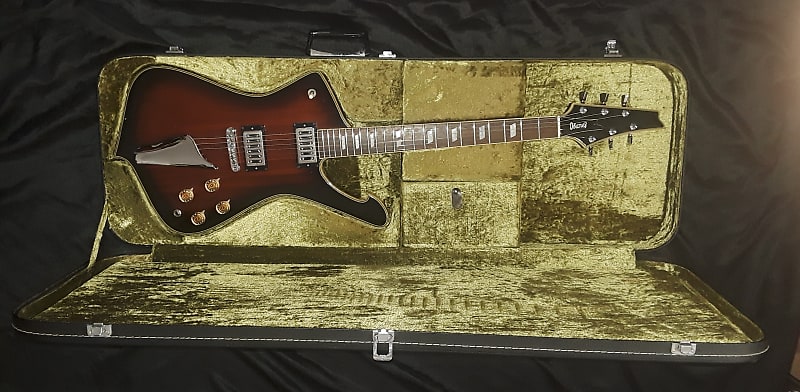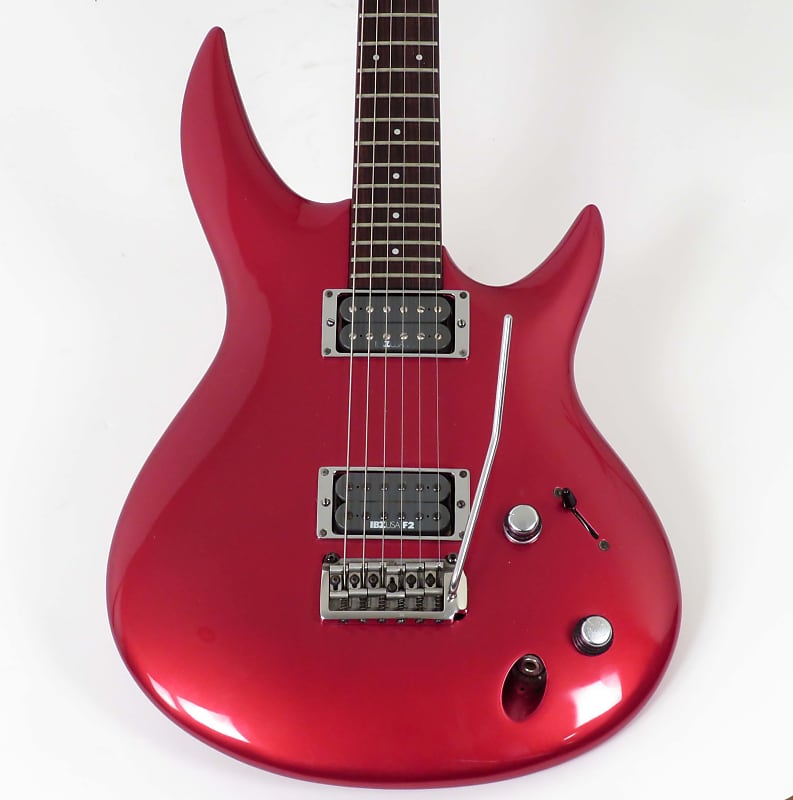As the '70s rolled in, many Japanese firms were busy copying American guitars. And in the case of the Ibanez brand, its Japanese parent company Hoshino established a US base in 1972, hooking up with Harry Rosenbloom's Elger operation in Philadelphia.
Harry had been selling Hoshino products in the States since the start of the '60s, and by now he had a thriving line of Ibanez copies to sell. Gibson lookalikes in the '72 catalogue included five Les Pauls, four SGs, a Barney Kessel clone, and three ESs, as well as copies of a couple of Telecaster models, an Epiphone Caiola, a thinline Gretsch, and a Dan Armstrong See-Through.
The following year, however, something odd happened. In 1973, alongside all the regular copies, a new quartet of Ibanez electric solids appeared, the 2611, 2612, 2613, and 2614. With hindsight, the impression is that someone was deliberately trying to design instruments that were not blatant copies. The semi-circular control panels had more than a whiff of a Les Paul Recording about them, certainly, but the bound mahogany bodies with birch, maple, or mahogany tops had a symmetrical double-cut outline that you could call original. And the bolt-on necks had unusual star-in-block markers.

The headstock on these four new-for-'73 models—grouped under a new "Artist" series name—was not Ibanez's customary copy of Gibson's venerable dove-wing design. Instead, these Artists had a new headstock shape. It became known as the castle head, because if you squinted (and used your imagination) its high sides and central dips resembled a castle's battlements. More importantly, it was Ibanez's first original headstock design.
A further early stab by Ibanez at original designs came with the Custom Series, introduced in 1974 and including another try at a double-cut, the 2662, plus an odd scroll-head Les Paul, the Custom Agent 2405, with fancy inlays to the body and fingerboard, and three Strats with carved bodies and heads, the Artwood 2408 Nouveau, Orient, and Eagle. It was at this time that Harry Rosenbloom sold his share of the US business to Hoshino, which became the sole owner of Elger Company.
In 1975, there was an even more striking addition to these early Ibanez originals. At first it was given model number 2663 and called The Flash, but soon its better-known name was in place: Iceman.
Again, influences were at work, but the result was an original concoction. The Iceman's body looked as if someone had given a Gibson Firebird a curved, pointed base and added a Rickenbacker-like hooked lower horn, providing a deep, easy-access cutaway, and to top it all there was a long, pointy headstock. This guitar unashamedly attracted attention.
Fritz Katoh, who in 1972 had established Hoshino's R&D department at the company's HQ in Nagoya, Japan, was one of those involved in the Iceman's design. Hoshino joined with a Japanese distributor, Kanda Shokai, which had its own brand, Greco, that like Ibanez was manufactured principally at the Fujigen factory in Matsumoto.
It wasn't unusual for similar Fujigen-made models to turn up with a number of different brand names, including Ibanez and Greco but running to many others, as determined by each customer. Greco's M series of guitars, for example, was the Iceman design under a different name.

The original Iceman offered from 1975 to '78 came in three versions: the 2663-3P or 2663TC, with one three-coil pickup, two controls, and a four-way tone selector; the 2663, with two humbuckers and four controls; and the 2663SL, with one sliding three-coil pickup and three controls.
This important new design for Ibanez prompted several later variations and offshoots, including in 1978 a signature model named for Paul Stanley. Ibanez also made him a custom PS10 with a cracked-mirror front, providing some spectacular reflections at Kiss's already dazzling live shows.
Meanwhile, Gibson had gained a trademark for its dove-wing headstock in 1975, the only trademark the company had for a body or headstock shape. By the time Ibanez's 1976 catalogues appeared, the brand had another new headstock. In January, management representatives from Hoshino in Japan had visited the US to discuss what one insider described as "the problem with Gibson" and decided on what they called "a new direction for 1976." It's likely that the new Ibanez headstock shape was part of that decision.
A first hint of more advances in Ibanez's developing design style had come in 1974 with the 2402VI Artwood Twin, a custom double-neck. At $1,500 it was by far the most expensive electric on the price list. It looked expensive, too, with a solid double-double-cutaway ash body in natural finish and very fancy appointments. In fact, it was a copy—of the Double Rainbow that Rex Bogue had built for John McLaughlin at Ren Ferguson's workshop in California.

Like any double-neck, the Twin had limited practical appeal, and Ibanez sensibly adapted aspects of its design into some rather more mainstream models. The first result, in a 1975 catalogue, was the 2617. It showcased the new Bogue-borrowed style of the Twin in single-neck form, with German-carve solid ash body and set neck, a pair of humbuckers, and Ibanez's Gibraltar bridge plus tailpiece.
The 2617's fingerboard had fancy pearl-and-abalone block markers, and the headstock was the "castle" type of the early Artists. All in, this guitar had the air of something classy and different, and compared to the Twin it was pitched at a much more approachable $450, when a Les Paul Deluxe listed at $580 and a regular Stratocaster at $405.
Ibanez's Artist and Professional models that followed drew from that template, with variations along the way. The 2617 was renamed the Artwood Artist in Ibanez's 1976 sales material and was joined in a revised Artist series by two more new models: the 2618 Artist 24, with maple/mahogany body and a bound 24-fret ebony fingerboard with dot markers; and the 2619 Artist 22, a 22-fret version with the 2617's fancy block markers and some useful pickup-switching combinations.
Also new for '76 were models for the Grateful Dead's Bob Weir and country session player Randy Scruggs, marking Ibanez's first signature guitars and the first entries in the new Professional series. The connection with Bob Weir came via Jim Fisher, who had started at Elger in 1973 as a guitar inspector and quality controller.
Jim was vocal in his suggestion that Ibanez needed a major rock guitarist's endorsement. One afternoon in 1974, he took some guitars to a Grateful Dead soundcheck at the Philadelphia Civic Center, and Bob took a shine to the Rex Bogue-style double-neck, asking if Ibanez could make him a six-string like it.
Bob told Elger's Jeff Hasselberger he wanted a sliding pickup, to help get the sounds he needed to hear, and Ibanez at first built him a guitar with a sliding single-coil between two humbuckers, and then a second guitar, which became the basis for the pair of signature models that appeared in '76: the 2680 Bob Weir Standard, with dot inlay, and the 2681 Bob Weir Pro, with vine inlay.
Although these signature models were part of the Professional series, they were very similar to the new Artist style, derived from the double-neck that had caught Bob's attention, with German-carve ash bodies.
"We started an ongoing relationship on all sorts of gizmos and effects with Bob," Jeff Hasselberger told me when I wrote my book about Ibanez. "He'd use them on stage, and in some cases created some truly awful sounds with them. Jerry Garcia was ribbing me about some of the failed attempts, and he said: 'You're like an evil doctor conducting experiments on our band—the Evil Doctor Hasselberger.' And that name stuck."
In 1977, Ibanez (via its Elger US arm) was the target of a legal complaint by Gibson. The company's boss, Chuck Schneider, had finally had enough of all the copying that was going on. He wrote to his dealers: "We have previously taken steps to warn various suppliers to stop copying, and, after exhausting our patience, we have begun this legal action. We intend to use every available means to stop others from trading on the valuable assets of Gibson."
Gibson and Ibanez/Elger settled out of court, with Elger agreeing to stop infringing Gibson's trademarked headstock design—which, as we've seen, Ibanez had already done—and to stop using Gibson-like model names in sales material. In February 1978, Gibson's complaint was closed.
Ibanez continued to develop new instruments, its momentum for change well under way. There were signature models for George Benson (1977), more Artist models, and the Concert, Musician, and Studio series (1978).

As the '80s began, the Roadstar II series emerged, and Ibanez tried its hand at various superstrat competitors, including the short-lived and adventurous Maxxas, as well as a trio of models at first known as the Pro540s: the P (Power), R (Radius), and S (Saber), the latter becoming a longstanding design in the brand's lines.
The most important breakthrough of the '80s for Ibanez came with Steve Vai's JEM models and the associated RG design, introduced in 1987. In many ways, these were the culmination of a drive for change that from the early '70s had steered Ibanez away from copies and toward original guitars.
Back in 1977, Roy Miyahara at Elger contacted a colleague back at Hoshino/Ibanez HQ in Japan about the "official lawsuit letter" Gibson had sent them. "I thought sooner or later we'd have to do business without the copy lines," he wrote, "but I'm surprised that it has come so soon, and it's a good opportunity for Hoshino."
Gibson can't have intended such an outcome, but it was indeed a good opportunity, and one that helped to propel Ibanez to its healthy position in the international guitar market.
About the author: Tony Bacon writes about musical instruments, musicians, and music. His books include Electric Guitars: Design And Invention and The Ibanez Electric Guitar Book. Tony lives in Bristol, England. More info at tonybacon.co.uk.
